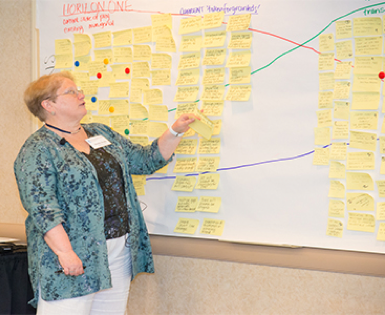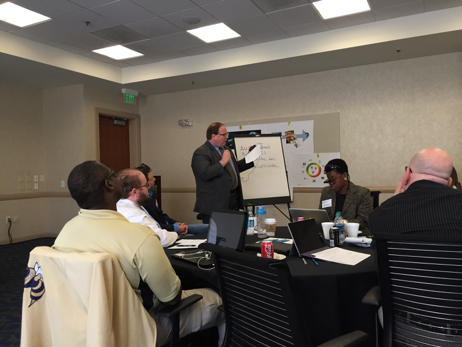From the third horizon the participants began to define the second horizon in which they would build new futures. In the image below Dr. Schultz diagrams the three Horizons approach via the stickers which were placed on the 9 presentations and subsequent feedback from day one discussions.

Horizon Two is where the action takes place that creates a preferred future, but first one has to envision that future in order to know what the goal is (i.e. Horizon Three). In this round of discussions participants determined how to use emerging changes to generate innovations and transformative actions that would create their preferred future. They prioritized three of the Future visions and began mapping the pathways to those inclusive futures; identifying needed knowledge, resources and allies. Each group shared their discussions and all attendees collaboratively developed a range of innovative inclusive futures in order to craft a Futures research and policy agenda.
As our facilitator Wendy Schultz noted “In the valley between the decline of Horizon One assumptions and conditions, and Horizon Three emerging change, is the turbulence of Horizon Two, where transition technologies, strategies, conflicts, and opportunities may erupt.”

The working groups resumed conversation and began to fine tune possible outcomes and conclusions. They were instructed to consider wireless technology access and implications in order to craft a FUTURES research and policy agenda. They were further tasked with answering a series of questions:
- What ethical challenges might arise?
- What constraints will we need to overcome?
- Who is shouldering costs we need to ameliorate/compensate?
- What jobs/careers will disappear?
- What new ones will emerge?
- What resources are needed?
- Who are our allies?
- What do we need now to make this vision possible?
Each group presented summaries of their visions. Many of the groups focused on describing their preferred futures and determining what current trends and emerging changes would contribute to the realization of their aspirational visions for the future.

- If you had to have a metaphor or tagline for your preferred future, what would it be?
- What are the emerging changes that will negate the identified assumption?
Following are some samples from each group’s preferred futures.
“Living, learning, earning!”
- ‘Just part of the landscape’ – stigma goes, disability remains
- Federal, state, local regulations changing
- Employment – shifts in attitudes more widely as both employers and workers have more positive experiences with disabled workers
- Assistive technologies are becoming better, faster, smaller, cheaper > this means that the obvious signs of disability will diminish over time, as ATs become ‘invisible’
- Increasing public education and awareness
- Increasing incorporation of inclusion re: disability in corporate and business equality / inclusiveness
- General acceptance of disability, increasing socialization regarding diversity
- Futures is with the next generation >> their values are more inclusive and less stigmatizing
“What disability?”
- Universal design; access to technology a basic civil right; ubiquitous communication
- “I’ll have my SAR contact your SAR”; hyper-abilities; ability to adjust environment via real-time data; social communication technologies = a basic right; assistive technologies will not always be necessary – use will be a personal preference
- Assumptions to overcome: disability will always be a stigma; some AT is good enough – why change?; people with disabilities will always need caregivers
- Changes that could contribute to the new future:
- Everyone will want these technologies! – transporters at home, work, leisure, community (beam me up; gateways), also exo-skeletons, jet-packs, autonomous vehicles
- Drones flying ahead of you to sense the environment, your response to it, and your interactions with it, in order to assist you
- ‘From disabilities to hyper-abilities’: could really affect the ADA fundamentally
“New Prometheus”
- New norms (functioning of society is normative); ‘all sparrows fly’ – from medical to functional outcomes
- Assumptions to overcome: basic ADA definition of disability; public policy tied to medical outcomes rather than functional and societal outcomes
- Changes that could contribute to the new future:
- New technologies are equivalent to receiving fire: they will transform the individual and society
- Humans, technologies, and the environment will blur together >> seamless, pervasive
- Technology is rapidly evolving – power, computing, new materials, biochemistry, etc.
- With wireless Internet of Things, wired up humans are simply another node in the IOT
- Policy changes can drive change
- Eliminate distinctions between humans and technology: don’t isolate people from technology, make it a basic right
- Apply societal outcomes to the entire system
“Like oxygen, it just works”
- “I am not my mother-in-law’s robot’s keeper.”
- Power, connectivity, technical updates – all just work BY THEMSELVES
- Novices are EAGER to begin using innovative technologies
- Bug-free systems
- Users understand basic design concepts (camera must be pointing at me to see me)
- “If this, then do this, then do that” – computational thinking necessary to be successful user of the Internet of Things
- All this accomplished by your staff … a crowd of intelligent agents
- Assumption to overcome: technology requires expertise and training – technical bugs are inevitable
- Allies: An always on, always ready, always working technology ecosystem will require a lot of power, so power companies would need to be early allies.
“Augmentation becomes universal and UNEXCEPTIONAL”
- Assumption to overcome: disability implies disadvantage
- Changes that could contribute to the new future:
- Transformed relationships between people and the environment
- Human learn with, from, about their environment
- All technology is assistive and ubiquitous
- Environment is responsive to everyone in it, eg, smart cities
- We learn in radical new ways from the environment via extended, extensive new sensory capabilities
- Levelling the playing field of abilities
- Tailored, personalised, and readily accessible technologies
“Universal usability!”
- Assumption to overcome: accessibility is too hard
- Changes that could contribute to the new future:
- Discoverability – what’s available to address my issue? The assistive technology finds YOU.
- People with disabilities involved throughout the innovation process
- Disability is not a special case of use
- Produce, service, package designers – all aware of the full diversity of usability / disability issue, resulting in end-to-end friendliness / usability of design
- Requires accessible education and skills training, and tools, to get there
- Best practices in usability and accessible design need to be available to create the success criteria for usable design







